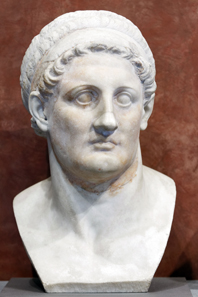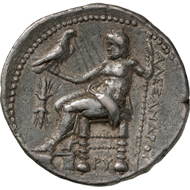with the kind permission of the MoneyMuseum, Zurich.
Why is it that for centuries – or rather thousands of years – the head has served as the motif for the side of a coin? And why has this changed in the last 200 years? Ursula Kampmann poses these questions in her book ‘MenschenGesichter,’ from which the texts for our new series are taken.
Ptolemy I in a marble likeness. Louvre, Paris. Photo: Wikipedia.
After the death of Alexander in the year 323 BC, Ptolemy, experienced troop leader and member of Alexander’s personal bodyguards, was awarded the Satrapy of Egypt. This didn’t mean, however, that Ptolemy now had carte blanche to do as he wished – he remained under the official control of the regent Perdikkas, and so acknowledged the rights of Alexander’s successors.
Just two years later, Ptolemy achieved his greatest success. In the year 321 BC, he managed to hijack the corpse of the great Macedonian. He took advantage of the fact that every new Macedonian ruler traditionally showed honour for the death of his predecessor. To this end, Alexander should have been transferred to his native Aegae, but in order to suitably equip and outfit the transport of a world conqueror, long preparations were required. It was only towards the end of the year 322 BC that the funeral procession set off. But instead of taking the closest route and ferrying from a Syrian port directly over to Macedonia, the ringleader brought the solemn procession to Egypt, where he collected the immense sum of bribe money that Ptolemy had offered him. The official announcement by the Satrap of Egypt was that Alexander had requested on his deathbed to be buried in Alexandria, the city he had founded.
Ptolemy I, Satrap of Egypt (323-318 BC). Tetradrachm, Alexandria, around 320 BC. Head of Alexander the Great with royal band and Ammon’s horn, elephant hood upon the head, and under the chin, the knotted aegis. Rev. Zeus enthroned, facing left, eagle upon the outstretched right hand. © MoneyMuseum, Zurich.
The annexation of the relics with respect to the royal corpse may ultimately have provided occasion for the first coinage, which handed down for posterity the realistic facial features of Alexander. Ptolemy had Alexander depicted as god with the ram’s horn of Zeus-Ammon. He also has the aegis wrapped around his neck, a magical, shield-like super weapon that the Greeks conceived of as a goat’s skin, as they derived the word ‘aegis’ – wrongly – from ‘aix’ (Greek = goat). The aegis actually belonged to Zeus. But he was known to loan it out on occasion, and so it’s likely that no viewer was surprised by the fact that Alexander, as the son of Zeus, had it in his possession. The elephant hood worn on Alexander’s head symbolizes the conquests that the youthful commander had made in India. This seemingly superhuman accomplishment proved, according to ancient belief, that Alexander, just like Dionysus, son of Zeus and, according to myth, the first to reach India, was truly descended from the father of the gods himself.
The next chapter will look at Macedonia’s war against the rising superpower of Rome.
All sections of the series can be found here.
The book ‘MenschenGesichter’ is available in printed form from the Conzett Verlag website. It soon will be translated to English.






